| PDCD2 | |||||||||||||||||||||||||||||||||||||||||||||||||||
|---|---|---|---|---|---|---|---|---|---|---|---|---|---|---|---|---|---|---|---|---|---|---|---|---|---|---|---|---|---|---|---|---|---|---|---|---|---|---|---|---|---|---|---|---|---|---|---|---|---|---|---|
| Identifiers | |||||||||||||||||||||||||||||||||||||||||||||||||||
| Aliases | PDCD2 , RP8, ZMYND7, programmed cell death 2 | ||||||||||||||||||||||||||||||||||||||||||||||||||
| External IDs | OMIM: 600866 MGI: 104643 HomoloGene: 1951 GeneCards: PDCD2 | ||||||||||||||||||||||||||||||||||||||||||||||||||
| |||||||||||||||||||||||||||||||||||||||||||||||||||
| |||||||||||||||||||||||||||||||||||||||||||||||||||
| |||||||||||||||||||||||||||||||||||||||||||||||||||
| |||||||||||||||||||||||||||||||||||||||||||||||||||
| |||||||||||||||||||||||||||||||||||||||||||||||||||
| Wikidata | |||||||||||||||||||||||||||||||||||||||||||||||||||
| |||||||||||||||||||||||||||||||||||||||||||||||||||
Programmed cell death protein 2 is a protein that in humans is encoded by the PDCD2 gene. [5] [6]
| PDCD2 | |||||||||||||||||||||||||||||||||||||||||||||||||||
|---|---|---|---|---|---|---|---|---|---|---|---|---|---|---|---|---|---|---|---|---|---|---|---|---|---|---|---|---|---|---|---|---|---|---|---|---|---|---|---|---|---|---|---|---|---|---|---|---|---|---|---|
| Identifiers | |||||||||||||||||||||||||||||||||||||||||||||||||||
| Aliases | PDCD2 , RP8, ZMYND7, programmed cell death 2 | ||||||||||||||||||||||||||||||||||||||||||||||||||
| External IDs | OMIM: 600866 MGI: 104643 HomoloGene: 1951 GeneCards: PDCD2 | ||||||||||||||||||||||||||||||||||||||||||||||||||
| |||||||||||||||||||||||||||||||||||||||||||||||||||
| |||||||||||||||||||||||||||||||||||||||||||||||||||
| |||||||||||||||||||||||||||||||||||||||||||||||||||
| |||||||||||||||||||||||||||||||||||||||||||||||||||
| |||||||||||||||||||||||||||||||||||||||||||||||||||
| Wikidata | |||||||||||||||||||||||||||||||||||||||||||||||||||
| |||||||||||||||||||||||||||||||||||||||||||||||||||
Programmed cell death protein 2 is a protein that in humans is encoded by the PDCD2 gene. [5] [6]
This gene encodes a nuclear protein expressed in a variety of tissues. The rat homolog, Rp8, is transiently expressed in immature thymocytes and is thought to be involved in programmed cell death. Expression of the human gene has been shown to be repressed by BCL6, a transcriptional repressor required for lymph node germinal center development, suggesting that BCL6 regulates apoptosis by its effects on PDCD2. This gene is closely linked on chromosome 6 to the gene for TBP, the TATA binding protein. Six transcripts encoding different proteins have been identified. [6]
PDCD2 has been shown to interact with Host cell factor C1 [7] and Parkin (ligase). [8]
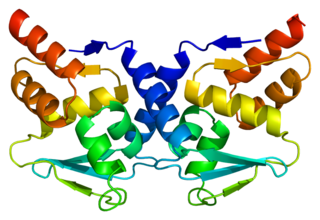
Bcl-6 is a protein that in humans is encoded by the BCL6 gene. BCL6 is a master transcription factor for regulation of T follicular helper cells proliferation. BCL6 has three evolutionary conserved structural domains. The interaction of these domains with corepressors allows for germinal center development and leads to B cell proliferation.

Death receptor 4 (DR4), also known as TRAIL receptor 1 (TRAILR1) and tumor necrosis factor receptor superfamily member 10A (TNFRSF10A), is a cell surface receptor of the TNF-receptor superfamily that binds TRAIL and mediates apoptosis.
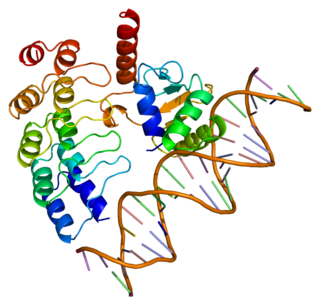
GA-binding protein alpha chain is a protein that in humans is encoded by the GABPA gene.

Serine/threonine-protein kinase 4 is an enzyme that in humans is encoded by the STK4 gene.

Host cell factor 1, also known as VP16-accessory protein, is a protein that in humans is encoded by the HCFC1 gene.

Inhibitor of growth protein 1 is a protein that in humans is encoded by the ING1 gene.

Beclin-1 is a protein that in humans is encoded by the BECN1 gene. Beclin-1 is a mammalian ortholog of the yeast autophagy-related gene 6 (Atg6) and BEC-1 in the C. elegans nematode. This protein interacts with either BCL-2 or PI3k class III, playing a critical role in the regulation of both autophagy and cell death.
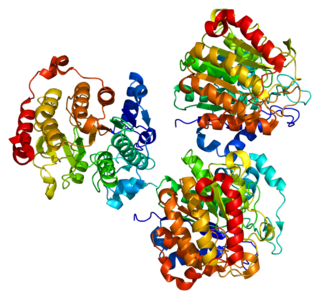
Histone deacetylase 7 is an enzyme that in humans is encoded by the HDAC7 gene.
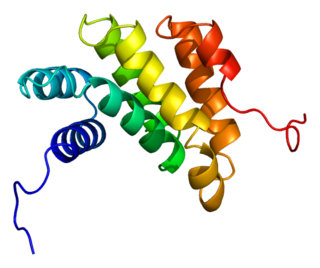
Programmed cell death protein 4 is a protein that in humans is encoded by the PDCD4 gene. It is one of the targets of an oncomiR, MIRN21.
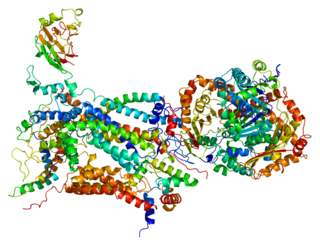
Cytochrome c1, heme protein, mitochondrial (CYC1), also known as UQCR4, MC3DN6, Complex III subunit 4, Cytochrome b-c1 complex subunit 4, or Ubiquinol-cytochrome-c reductase complex cytochrome c1 subunit is a protein that in humans is encoded by the CYC1 gene. CYC1 is a respiratory subunit of Ubiquinol Cytochrome c Reductase, which is located in the inner mitochondrial membrane and is part of the electron transport chain. Mutations in this gene may cause mitochondrial complex III deficiency, nuclear, type 6.

Cyclic AMP-responsive element-binding protein 3 is a protein that in humans is encoded by the CREB3 gene.

Zinc finger protein Aiolos also known as Ikaros family zinc finger protein 3 is a protein that in humans is encoded by the IKZF3 gene.

DnaJ homolog subfamily C member 3 is a protein that in humans is encoded by the DNAJC3 gene.

BCL-6 corepressor is a protein that in humans is encoded by the BCOR gene.

Ubiquitin-conjugating enzyme E2 variant 1 is a protein that in humans is encoded by the UBE2V1 gene.

WD repeat-containing protein 5 is a protein that in humans is encoded by the WDR5 gene.
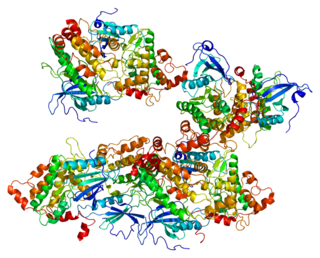
Death-associated protein kinase 2 is an enzyme that in humans is encoded by the DAPK2 gene.

ELL-associated factor 2 is a protein that in humans is encoded by the EAF2 gene. It is part of the EAF family of proteins.

Etoposide-induced protein 2.4 homolog is a protein that in humans is encoded by the EI24 gene.

B-cell CLL/lymphoma 6 member B protein is a protein that in humans is encoded by the BCL6B gene.